Eutech instruments PC 2700, CON 2700, ION 2700, PH 2700, DO 2700 Manual
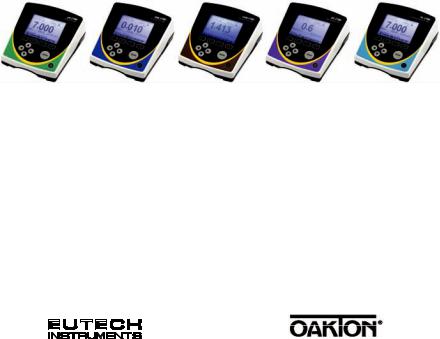
Instruction Manual
2700 Series Benchtop
Meters
pH 2700 ● ION 2700 ● CON 2700 ● DO 2700 ● PC 2700
Technology Made Easy ...
Part of Thermo Fisher Scientific 68X544001 Rev 1 Sep 2010
|
TABLE OF CONTENTS |
|
1. |
Introduction...................................................................................... |
1 |
2. |
Getting Started................................................................................. |
2 |
|
Keypad and Display ................................................................................................... |
2 |
|
Navigation of Tabs ..................................................................................................... |
3 |
|
Meter Connections..................................................................................................... |
4 |
3. |
System Setup & Configuration....................................................... |
5 |
|
Stability ....................................................................................................................... |
5 |
|
Stability Criteria.......................................................................................................... |
6 |
|
Auto Read ................................................................................................................... |
6 |
|
Print Set....................................................................................................................... |
7 |
|
Date & Time................................................................................................................. |
8 |
|
Password .................................................................................................................... |
8 |
|
Clear Datalog .............................................................................................................. |
8 |
|
Factory Reset.............................................................................................................. |
9 |
|
Contrast Adjustment.................................................................................................. |
9 |
4. |
Setup pH & mV................................................................................. |
10 |
|
Sample ID.................................................................................................................... |
10 |
|
Buffer (Group Selection)............................................................................................ |
10 |
|
Cal Points.................................................................................................................... |
11 |
|
Resolution................................................................................................................... |
11 |
|
Alarm ........................................................................................................................... |
11 |
|
Cal Due ........................................................................................................................ |
11 |
5. |
pH Calibration (with preset buffer group) ..................................... |
12 |
6. |
pH Calibration (with custom buffers) ............................................ |
14 |
7. |
Millivolt (mV) Calibration (Offset Adjustment).............................. |
16 |
8. |
Temperature Setup.......................................................................... |
17 |
9. |
Temperature Calibration ................................................................. |
18 |
10. Conductivity, TDS, Salinity, & Resistivity Setup .......................... |
19 |
|
|
Sample ID.................................................................................................................... |
19 |
|
Cal Points.................................................................................................................... |
20 |
|
Pure Water Coefficient............................................................................................... |
20 |
|
Temperature Coefficient (linear)............................................................................... |
20 |
|
Normalization Temperature (°C) ............................................................................... |
21 |
|
Cell Constant .............................................................................................................. |
21 |
|
Alarm ........................................................................................................................... |
22 |
|
Cal Due ........................................................................................................................ |
22 |
11. Conductivity Calibration (automatic)............................................. |
23 |
|
12. Conductivity, TDS, Salinity, & Resistivity Calibration (manual |
|
|
adjustment) ............................................................................................. |
25 |
|
13. |
Ion Setup .......................................................................................... |
27 |
|
Sample ID.................................................................................................................... |
27 |
|
Measure Unit............................................................................................................... |
27 |
|
Alarm ........................................................................................................................... |
27 |
|
Cal Due ........................................................................................................................ |
28 |
14. |
Ion Calibration.................................................................................. |
29 |
15. |
Dissolved Oxygen Setup ................................................................ |
31 |
|
Sample ID.................................................................................................................... |
31 |
|
Offset Cal (% saturation only)................................................................................... |
31 |
|
Pressure Unit (% saturation mode only).................................................................. |
31 |
|
Pressure Cal (% saturation mode only) ................................................................... |
32 |
|
Pressure Compensation (% saturation mode only)................................................ |
32 |
|
Measure Unit (concentration mode only) ................................................................ |
32 |
|
Salinity Value (concentration mode only)................................................................ |
33 |
|
Alarm ........................................................................................................................... |
33 |
|
Cal Due ........................................................................................................................ |
33 |
16. |
Dissolved Oxygen Calibration........................................................ |
34 |
|
100 % Calibration ....................................................................................................... |
34 |
|
0% Calibration ............................................................................................................ |
35 |
|
mg/L or ppm (Concentration) Calibration................................................................ |
35 |
17. |
Transferring and Printing Data....................................................... |
37 |
18. |
Calibration Report ........................................................................... |
38 |
19. |
Dissolved Oxygen Theory .............................................................. |
39 |
20. |
Calculating Temperature Coefficients........................................... |
42 |
21. |
Calculating TDS Conversion Factor .............................................. |
43 |
22. |
DO Electrode Maintenance ............................................................. |
44 |
23. |
Troubleshooting .............................................................................. |
45 |
24. |
Specifications .................................................................................. |
47 |
25. |
Replacements and Accessories..................................................... |
50 |
26. |
Warranty ........................................................................................... |
52 |
27. |
Return of Items ................................................................................ |
53 |
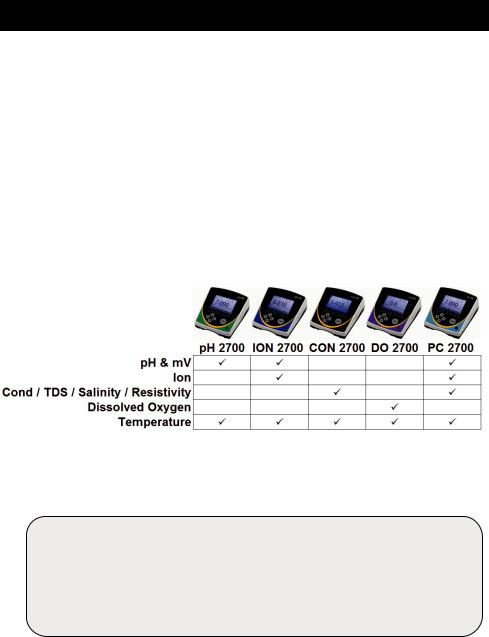
1.Introduction
Thank you for selecting our 2700 series research benchtop meter. This microprocessor-based instrument incorporates a large LCD for clear viewing, yet offers a small footprint to conserve space.
Each meter includes a convenient slide-out calibration card for quick reference. All models (except for DO 2700) include an electrode arm and metal bracket which can be easily attached to the left or right side of the meter according to your preference.
The 2700 series benchtop meter replaces our popular 1100 and 2100 series meters that were introduced in 2001.
Please note that this manual serves all 2700 models, so not all sections of the manual will be relevant to each model. The chart below lists the parameters served for the various models:
We take great pride in every instrument we manufacture and hope this one serves you well.
If you are viewing an electronic version of this manual, you can use hyperlinks located in the Table of Contents and elsewhere by holding down the CTRL key as you click the hyperlink.
Find other helpful tips listed in grey boxes like this one!
1
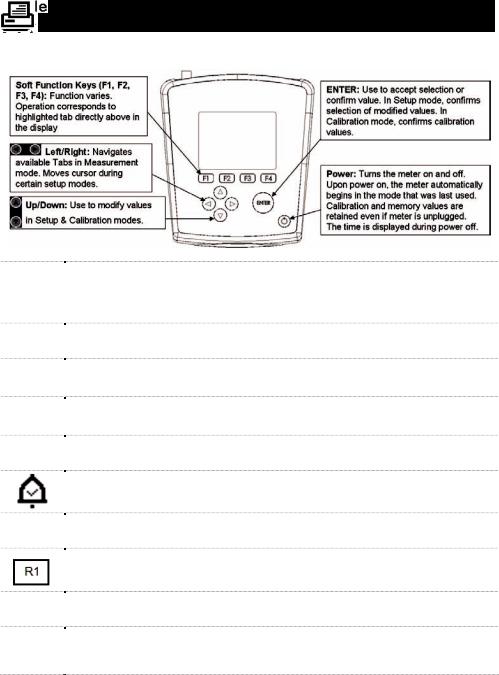
2.Getting Started
Keypad and Display
(ATC)
(MTC)
Auto Read is enabled. When flashing, the instrument has detected a ‘Stable’ reading and locked the value. Press MEAS to resume live reading. See Section 3—Auto Read to disable this feature, or go to SETUP…SYSTEM…AUTO READ.
Based on the stability criteria settings in System Setup, the instrument has detected a stable reading.
Password Protection: Enabled. Requires password for all calibration and setup menus
Password Protection: Disabled. No password required for any menu.
Print Setting Timed interval is active; data is being output at regular intervals.
“High Alarm”, “Low Alarm”, or “Cal Due” alarm limit had been reached. High/Low alarms also have an audible notification..
Sample ID: User selectable five digit number to identify samples.
Measuring Range # of displayed value (1 thru 5). Applicable to Conductivity, TDS, Salinity, or Resistivity measurements only
Automatic Temperature Compensation is active; temperature is being actively acquired with attached electrode. ATC is recommended.
Manual Temperature Compensation is active. A temperature sensor may not be attached so the default temperature is used. See Section 9—Temperature Calibration to calibrate the ATC or MTC temperature values.
2
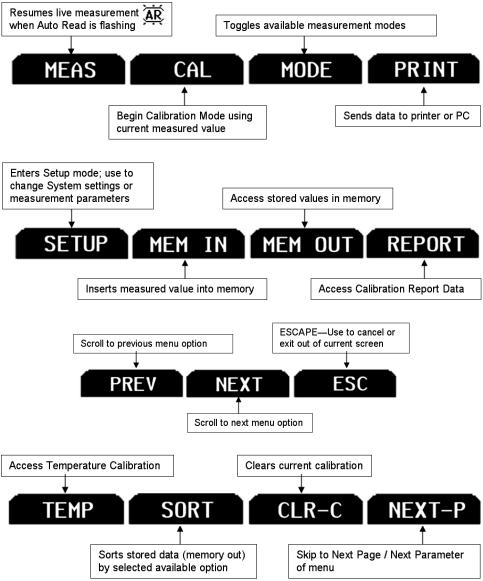
Navigation of Tabs
3
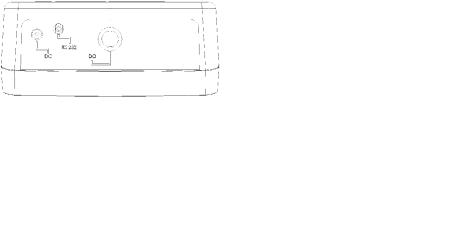
Meter Connections
pH 2700 |
PC 2700 |
|
ION 2700 |
||
|
|
CON 2700 |
DO 2700 |
|
|
|
|
|
DC |
|
Power supply |
|
|
|
|
|
RS-232 |
|
RS-232 output, 2.5 mm jack for RS-232 cable |
|
|
|
|
|
CON/TEMP |
8-pin DIN connection for 2-cell or 4-cell Con/TDS/Temp |
||
electrodes |
|
||
|
|
|
|
DO |
|
8-pin DIN connection for Dissolved Oxygen/Temp self stirring |
|
|
electrode |
|
|
|
|
|
|
|
|
|
|
ATC |
|
For Automatic Temperature Compensation probe. |
|
|
For PC 2700, this corresponds to the temperature |
||
|
|
measurement associated with the BNC (“pH”) input. |
|
|
|
Pin connection for half cell reference electrodes. |
|
REF |
|
Requires separate half cell electrode in the BNC (“pH”) input. |
|
|
|
Note: REF is not commonly used and is not required. |
|
|
|
|
|
pH |
|
BNC connection for combination pH, ORP (Redox), or Ion |
|
|
Selective Electrodes (ISE), or half-cell indicating electrodes. |
||
|
|
||
|
|
|
|
4

3.System Setup & Configuration
Use the System Setup to customize operation of your 2700 series meter.
Press  from the measurement screen and then press ENTER when SYSTEM is highlighted to access these settings.
from the measurement screen and then press ENTER when SYSTEM is highlighted to access these settings.
The following settings can be customized for each model:
STABILITY |
PRINT SET |
|
STABILITY |
DATE & TIME |
|
CRITERIA |
||
|
||
AUTO READ |
PASSWORD |
|
BACKLIGHT |
CLEAR DATALOG |
|
DATALOG |
FACTORY RESET |
|
PRINT SETUP |
CONTRAST |
|
PRINT FORMAT |
|
Stability
To aid with measurement and calibration, your meter has a unique feature that provides an obvious visual indication when the reading becomes stable. If the Stability feature is enabled, the digits on the primary reading will be faded when unstable, becoming solid when stable. If this feature is disabled, the primary reading will always be solid. The image below on the left is an unstable reading during pH Measurement mode with Stability enabled. The image on the right shows a stable reading.
5

Stability Criteria
The 2700 allows adjustment of the Stable indicator which relates to how fast and frequent it appears. There are three levels of adjustment; SLOW, MEDIUM, &
FAST.
To display a ‘Stable’ reading more quickly and more often, use “FAST” setting. MEDIUM or SLOW is recommended for most applications. When Auto Read is enabled, a stability criteria setting of “SLOW” is recommended to for best results.
SLOW: The Stable indicator will take longer to appear and will appear less frequently. Use this setting if you want the best results and don’t mind waiting longer to get them.
MEDIUM: This is the factory default setting. It provides a balanced response which works best for most applications.
FAST: The Stable indicator will appear quickest of any setting. If you find that the Stable indicator frequently appears and disappears, you may want to select a slower setting. This setting is not recommended when AUTO READ is enabled. It is also not suitable for most non-refillable electrodes which are generally slower to respond.
Auto Read
If AUTO READ is enabled, the measured value will automatically lock when the Stable indicator appears. A flashing “AR” icon confirms this condition. To resume a live reading again, it is necessary to press MEAS
each time Stable appears. Disable this feature to continuously view the active reading.
Backlight
Select “PERMANENTLY ON” on to keep the backlight on at all times that the meter is powered on. This will offer the best visibility but consumes the most power.
Select “ON WITH KEY PRESS” to turn on the backlight for a specified time after any key press. Select “0” to keep the backlight off at all times that the meter is powered on.
6
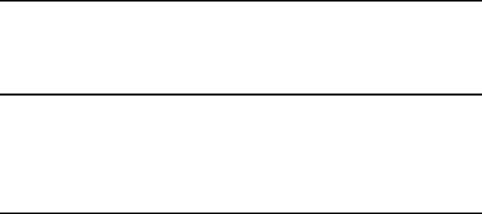
Data Log (storing data to internal memory)
Select “SINGLE” to manually save one point at a time. Press the “MEM IN” function key any time during measurement to save data.
Select “TIMED” to automatically save data at selectable intervals— ranging from 3 to 3600 seconds. Data will be collected until the data limit is reached or until “SINGLE” data log is selected. This feature is useful for gathering data from a single sample over time. Note that “MEM IN” is not available during TIMED setting. As data is collected, the display will indicate how much memory has been used.
To view stored data, use “MEM OUT”. Note: the more data that has been acquired memory, the longer the data will take to display.
Print Setup
Adjust the RS-232 output settings for baud rate, parity, data bit, and stop bit to match your printer or computer settings as necessary.
Print Format
When utilizing the RS-232 output; choose “TEXT/PRINTER” option to send the data in an easily viewable format—best for printing.
Choose “CYBERCOMM” option to send the data as a comma separated value (CSV)—best for exporting data into spreadsheet software.
Print Set
This is identical to the Data log function, but data is sent via RS-232 output instead of internal memory.
Select “SINGLE” to manually output one value at a time—best for printing or collecting data to your PC from many samples.
Select “TIMED” to automatically output live data at selectable intervals— ranging from 3 to 3600 seconds. Data will be output until “SINGLE” Print set is selected. This feature is most useful for gathering data for use with software. Unlike the Data Log setting, data can be saved to memory using “MEM IN” during TIMED setting.
7
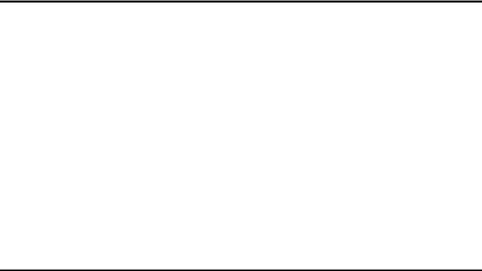
Date & Time
Setting the correct date and time is required for GLP and will apply to power off, measurement, data log, and print functions. Instrument has battery backup to retain date/time settings upon power loss. Factory reset will not apply to date and time setting once it has been set. Changes related to daylight savings time must be manually entered.
Date Format: Select (MM DD YY) or (DD MM YY) Time Format: Select 12Hrs (AM/PM) or 24Hrs
Password
Select “ENABLE” to restrict access to Calibration and Setup modes. When password protection is enabled, password entry is required before performing any calibration, or making changes to the setup mode. Setup parameters can be viewed, but can not be changed without correct password entry. The password is a user selectable number from 1 to 99999.
Select “DISABLE” if password protection is not desired.
The meter does not allow you to edit setup parameters or perform a new calibration unless you enter the correct password. If an incorrect password is entered 3 consecutive times, the meter returns to measurement mode.
In the event the password can not be recovered, a password can be provided via a written request to Eutech Instruments/Oakton Instruments. The instrument serial number and your contact information are required.
Clear Datalog
Select “YES” to delete all saved data that was manually or automatically stored into memory. This step is most commonly required when the “TIMED” data log interval is not turned off and as a result, fills the memory to capacity. When the memory is full, deleting the saved data is required in order to save additional data/ The 2700 will never erase old data in favor of new data when the memory is full.
If you wish to view, print or send the saved data to a PC before deleting, use the “MEM OUT” function from measurement mode.
8

Factory Reset
Select “YES” to reset the 2700 to the factory default settings except; Date & Time, Temperature calibration, and data stored in memory.
Contrast Adjustment
Optimize the contrast setting of your 2700 display for best visibility in your surrounding lighting conditions. Test various contrast settings for best results. This setting will be applied to both backlight and non-backlight conditions.
9

4.Setup pH & mV
Use Setup pH or mV mode to customize these parameters. Note: mV setup offers Sample ID and Alarm setting only.
Press  from the measurement screen and then press ENTER when pH or mV is selected.
from the measurement screen and then press ENTER when pH or mV is selected.
Sample ID
This is a user selectable number from 1 to 99999. Incorporating a sample ID to identify one or more data points is useful to distinguish data that is saved into memory or sent to a PC or printer. Use the up/down arrow keys to adjust the values and left/right arrow keys to move the cursor.
Buffer (Group Selection)
Choose one of (6) pH buffer groups for calibration; USA, NIST, DIN, USER 1, USER 2, and CUSTOM. The pH values in the selected buffer group are used for auto-recognition during pH calibration. Choose the appropriate buffer group, based on the pH calibration standards you intend to use.
Buffer Group |
pH Values |
USA |
1.68, 4.01, 7.00*, 10.01, 12.45 |
NIST |
1.68, 4.01, 6.86*, 9.18, 12.45 |
DIN |
1.09, 3.06, 4.65, 6.79*, 9.23, 12.75 |
USER 1 |
1.68, 4.01, 7.00*, 9.18, 12.45 |
USER 2 |
1.68, 4.01, 6.86*, 10.01, 12.45 |
CUSTOM |
Any 2 - 5 values, ≥ 1.0 pH unit apart |
|
|
10
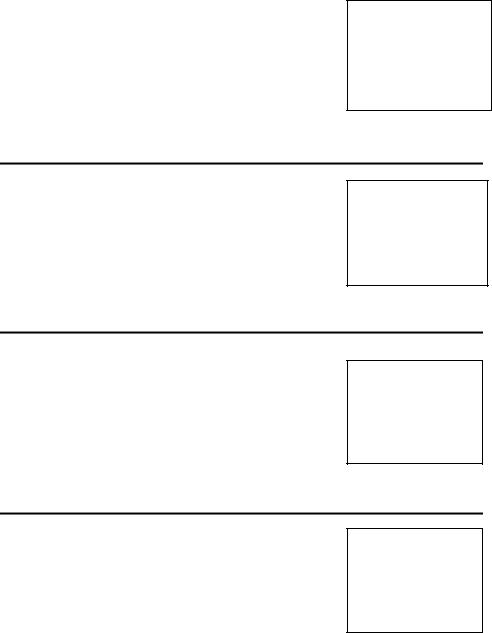
Cal Points
Specify the number of pH calibration points you intend to calibrate with. Select the number of calibration points from 1 to 5 with preset buffer groups or from 2 to 5 points with custom buffer group.
For example, if you have selected the USA buffer group which contains 5 standards, but you will only be using 3 standards (pH 4, 7, and 10), selecting 3 calibration
points here will speed up the calibration process—the 2700 will automatically recognize calibration is finished after the 3rd point has been completed.
Resolution
Select your desired pH resolution; 0.0, 0.00, or 0.000. Tip: Don’t choose more than you really need—0.00 is the factory default setting since it is most commonly used. Choosing 0.000 will lead to more “unstable” conditions and cause a delay in obtaining the final reading as the last digit (which is often not needed) changes.
Alarm
The 2700 offers a visual and audible alarm to alert you when the High or Low values that have been set from this menu are exceeded.
“High Alarm” or “Low Alarm” will blink on the display if the values are exceeded while simultaneously, a loud,
intermittent beeping sound is heard. The alarms will continue until the conditions are no longer met, and will only be active during measurement mode.
Cal Due
When enabled, the “Cal Due” indicator blinks if the number of days since the last calibration has been exceeded. Set the number of days from 1 to 31.
11

5.pH Calibration (with preset buffer group)
For best results, periodic calibration with known accurate standards is recommended prior to measurement. Calibrate with standards that bracket your intended measuring range while including a neutral point (7.00, 6.86, or 6.79). For example, if you expect to measure samples from pH 6.2 to 9.5, calibration with 4.01, 7.00, and 10.01 will work well.
The 2700 series meters can be calibrated with up to 5 preset or custom buffers (up to 6 with DIN buffer group). The non-volatile memory retains all calibration values upon meter shut down.
The 2700 series automatically recognizes the following pH calibration buffers in the groups listed below. See Section4—Buffer to select a different buffer group;
|
Buffer Group |
pH Values |
|
|
USA |
1.68, 4.01, 7.00*, 10.01, 12.45 |
|
|
NIST |
1.68, 4.01, 6.86*, 9.18, 12.45 |
|
|
DIN |
1.09, 3.06, 4.65, 6.79*, 9.23, 12.75 |
|
|
USER 1 |
1.68, 4.01, 7.00*, 9.18, 12.45 |
|
|
USER 2 |
1.68, 4.01, 6.86*, 10.01, 12.45 |
|
|
CUSTOM |
Any 2 - 5 values, ≥ 1.0 pH unit apart |
|
*Required as 1st calibration point value (offset determination)
To eliminate temperature errors associated with the pH electrode, attach the automatic temperature compensation (ATC) probe for best accuracy. Without temperature compensation, pH accuracy will worsen as samples deviate from 25ºC and pH 7.
If the pH electrode has been stored dry, soak in storage solution for 10 minutes before calibrating or taking readings to saturate the pH electrode surface and minimize drift. If storage solution is not available, use a neutral pH buffer. Do not reuse buffer solutions after calibration. Contaminants in the solution can affect the calibration, and eventually the accuracy of the measurements.
1)Turn meter on, press MODE if needed for pH Measurement.
2)Rinse the pH and ATC electrodes with clean water then submerse in neutral pH buffer—the 1st calibration point must be either 7.00, 6.86, or 6.79 depending on the buffer group used.
3)Press CAL to enter calibration mode.
12
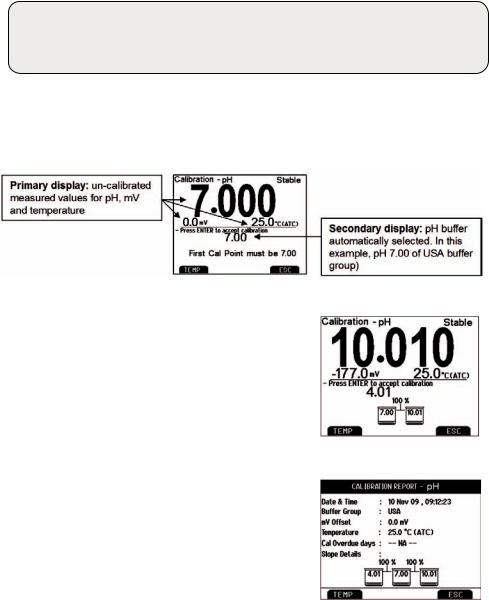
If the meter is password protected, you will be prompted to enter a password. See Section 3—Password.
4)The primary display is the un-calibrated measured value. The 2700 automatically searches for and selects the appropriate value from your buffer group in the secondary display. This value will blink when the ‘Stable’ indicator appears. Selecting CLR-C will clear the existing calibration.
5)Press ENTER to accept the calibration value of the measured buffer. When successful the accepted value will be visible inside of a beaker icon. Percentage slope is visible after two or more calibration points have been completed.
6)Repeat Steps 4 & 5 with additional pH buffers in any order or press ESC to escape and save your calibration. When the specified number of
calibration points is met, the pH calibration report page is automatically displayed. To specify a different number of pH calibration points see Section 4—Cal Points.
13

6.pH Calibration (with custom buffers)
|
Buffer Group |
|
pH Values |
|
|
CUSTOM |
|
Any 2 - 5 values, ≥ 1.0 pH unit apart |
|
1) Turn meter on, press |
MODE if needed for pH measurement mode. |
|||
2)Rinse the pH and ATC electrodes then submerse in your custom pH buffer— any pH value can be used.
3)Press CAL (enter password if required) to enter calibration mode. If desired, select CLR-C to clear the previous calibration. The lower pH value corresponds to the factory default setting for reference. When stable, use the up/down arrows to adjust the upper pH value to your custom pH buffer value.
For best results, enter the value of the buffer that corresponds to the measured temperature. For example, pH 10 buffer is actually 10.06 at 20°C, so adjust to 10.06 instead of 10.00 if the temperature is 20°C.
4)Press ENTER to accept the calibration value. When successful, the accepted value will be visible inside of a beaker icon.
14
